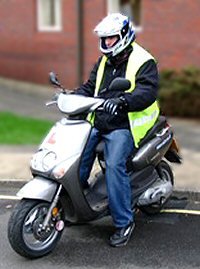Moped definition |
License |
Registration |
Laws |
Restrictions |
Equipment
A moped, sometimes called a "scooter," is a motor vehicle with the engine
 as an integral part of the vehicle. If the engine is an add-on it's likely the vehicle is a motor bicycle, which has limited operation on highways different from motorcycles and mopeds. A moped engine may not exceed 50 cubic centimeters (CCs) in size with an automatic transmission, or 130 CCs in size if it is a bicycle type vehicle with fully operative pedals for propulsion by human power.
as an integral part of the vehicle. If the engine is an add-on it's likely the vehicle is a motor bicycle, which has limited operation on highways different from motorcycles and mopeds. A moped engine may not exceed 50 cubic centimeters (CCs) in size with an automatic transmission, or 130 CCs in size if it is a bicycle type vehicle with fully operative pedals for propulsion by human power.
Traditionally, mopeds had fully operative pedals but modern mopeds are usually more like small motorcycles with an automatic transmission and no pedals.
Licensed drivers only
Generally, anyone with a valid Class D (regular or probationary) driver license may operate a moped; however, it is not legal to operate a moped with only a valid instruction permit (temps). If you wish to operate a moped, but do not have a Class D regular/probationary license, you could apply for a Moped Permit. You must be at least 16 years old and have completed an approved driver education course. You might qualify for a Special Restricted License, restricted to operation of motorbikes, mopeds or special vehicles designed to travel less than 35 miles per hour, issued to those who don’t otherwise qualify for a driver license due to physical challenges. Your nearest
driver license examination station can give you details.
Registration a must
You must register your moped, and you must obtain a certificate of title. If you buy from a dealer, this will be taken care of as part of the purchase transaction. But if you buy from a private party, make sure you obtain a title from the seller that has been signed by all owners and from which all loans have been cleared by the lending agency.
Obey traffic laws
Mopeds are subject to all traffic laws just like any other motor vehicle. You must obey traffic signals and stop signs, yield to pedestrians in crosswalks and slow down in school zones.
On roads where the speed limit is 25 MPH or less, two mopeds may operate side-by-side if both riders agree. On roads where the speed limit is more than 25, mopeds must ride single file. On roads with two or more lanes in each direction, mopeds must operate in the right lane except when turning left.
Restrictions and entitlements
You may ride your moped on any roadway except freeways or roads where mopeds are specifically prohibited. You may not operate a moped on sidewalks, along fence lines or off the traveled surface of the roadway.
Mopeds are entitled to a full traffic lane but may not impede traffic. Mopeds may use bike paths if signs permit them or where they are required by local law to use bike paths. Don't operate a moped on private property without the property owner's permission. Mopeds may park in spaces designated for other motor vehicles, in bicycle racks or on sidewalks, unless otherwise prohibited. But avoid riding on sidewalks or interfering with pedestrians.
Mopeds are designed for only one person. It is illegal to carry a passenger on a moped.
Safety and equipment
Mopeds must meet federal emission, safety and equipment standards in effect at the time of manufacture. Brakes, lights and turn signals must be maintained in safe working order.
Wisconsin does not require moped drivers to wear helmets, but be aware that a moped offers the rider almost no protection in case of a crash. Even at relatively slow moped speeds, head injuries in moped crashes are common. A US DOT approved helmet is the best protection against serious injury.
Mopeds must use headlights when driving at night, but unlike motorcycles, there is no requirement for headlight use during the day. However, headlights turned on during the day can greatly improve moped visibility to other motorists, and it is a very good safety practice.
Related information: